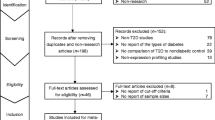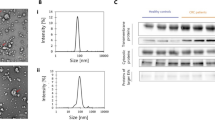Abstract
Background
MicroRNA (miRNA) has been shown the potential of cancer diagnosis. We investigated whether plasma miRNA expression could discriminate between patients with and without gastric cancer.
Methods
This study was divided into three steps: (1) miRNA microarray profiling on plasma samples from 20 gastric cancer patients and 20 healthy controls; (2) miRNA selection by real-time qRT-PCR on 30 pairs of plasma from patients and controls; and (3) qRT-PCR validation on an independent set of plasma from 180 gastric cancer patients, 80 healthy controls, and 20 patients with gastric precancerous diseases.
Results
Of the 959 human miRNAs analyzed by microarray, 37 up-regulated miRNAs and seven down-regulated miRNAs were found in gastric cancer plasma. Of the seven discrepant miRNAs validated on the plasma from 30 gastric cancer patients and 30 healthy controls, both miRNA-199a-3p and miRNA-151-5p were significantly elevated (p < 0.05) and were significantly reduced after surgery (p < 0.05) in gastric cancer patients. Further large-scale validation showed that these two miRNAs expressions in plasma were significantly higher in gastric cancer patients than healthy controls and patients with gastric precancerous diseases, respectively. However, only the expression of miRNA-199a-3p in plasma was significantly associated with tumor invasion and with lymph node metastasis and tumor, node, metastasis stage. This marker yielded an area under the receiver operating characteristic curve area of 0.837 with 80 % sensitivity and 74 % specificity in discriminating gastric cancer patients from healthy controls. In gastric cancer tissue, miRNA-199a-3p was expressed in the cytoplasm of tumor cells.
Conclusions
miRNA-199a-3p in plasma could be a novel potential diagnostic biomarker for gastric cancer detection.





Similar content being viewed by others
References
Jemal A, Tiwari RC, Murray T, et al. Cancer statistics, 2004. CA Cancer J Clin. 2004;54:8–29.
Yang L, Parkin DM, Ferlay J, et al. Estimates of cancer incidence in China for 2000 and projections for 2005. Cancer Epidemiol Biomark Prev. 2005;14:243–50.
Gotoda T, Yamamoto H, Soetikno RM. Endoscopic submucosal dissection of early gastric cancer. J Gastroenterol. 2006;41:929–42.
Carpelan-Holmstrom M, Louhimo J, Stenman UH, et al. CEA, CA19-9 and CA72-4 improve the diagnostic accuracy in gastrointestinal cancers. Anticancer Res. 2002;22:2311–6.
Fernands LL, Martins LC, Nagashima CA, et al. CA72-4 antigen levels in serum and peritoneal washing in gastric cancer. Correlation with morphological aspects of neoplasia. Arq Gastroenterol. 2007;44:235–9.
He L, Thomson JM, Hemann MT, et al. A microRNA polycistron as a potential human oncogene. Nature. 2005;435:828–33.
Calin GA, Croce CM. MicroRNA signatures in human cancers. Nat Rev Cancer. 2006;6:857–66.
He L, He X, Lim LP, et al. A microRNA component of the p53 tumor suppressor network. Nature. 2007;447:1130–4.
Resnick KE, Alder H, Hagan JP, et al. The detection of differentially expressed microRNAs from the serum of ovarian cancer patients using a novel real-time PCR platform. Gynecol Oncol. 2009;112:55–9.
Chim SS, Shing TK, Hung EC, et al. Detection and characterization of placental microRNAs in maternal plasma. Clin Chem. 2008;54:482–90.
Xia L, Zhang D, Du R, et al. miR-15b and miR-16 modulate multidrug resistance by targeting BCL2 in human gastric cancer cells. Int J Cancer. 2008;123:372–9.
Mitchell PS, Parkin RK, Kroh EM, et al. Circulating microRNAs as stable blood-based markers for cancer detection. Proc Natl Acad Sci USA. 2008;105:10513–8.
Lawrie CH, Gal S, Dunlop HM, et al. Detection of elevated levels of tumor-associated microRNAs in serum of patients with diffuse large B-cell lymphoma. Br J Haematol. 2008;141:672–5.
Wong SC, Lo SF, Cheung MT, et al. Quantification of plasma beta-catenin mRNA in colorectal cancer and adenoma patients. Clin Cancer Res. 2004;10:1613–7.
Liu R, Zhang C, Hu Z, et al. A five-microRNA signature identified from genome-wide serum microRNA expression profiling serves as a fingerprint for gastric cancer diagnosis. Eur J Cancer. 2011;47:784–91.
Tsujiura M, Ichikawa D, Komatsu S, et al. Circulating microRNAs in plasma of patients with gastric cancers. Br J Cancer. 2010;102:1174–9.
Chen XQ, Bonnefoi H, Pelte MF, et al. Telomerase RNA as a detection marker in the serum of breast cancer patients. Clin Cancer Res. 2000;6:3823–6.
Lo KW, Lo YM, Leung SF, et al. Analysis of cell-free Epstein–Barr virus associated with RNA in the plasma of patients with nasopharyngeal carcinoma. Clin Chem. 1999;45:1292–4.
Li X, Zhang Y, Zhang Y, et al. Survival prediction of gastric cancer by a seven-microRNA signature. Gut. 2010;59:579–85.
Chen X, Ba Y, Ma L, et al. Characterization of microRNAs in serum: a novel class of biomarkers for diagnosis of cancer and other diseases. Cell Res. 2008;18:997–1006.
Garzon R, Volinia S, Liu CG, et al. MicroRNA signatures associated with cytogenetics and prognosis in acute myeloid leukemia. Blood. 2008;111:3183–9.
Yu T, Wang XY, Gong RG, et al. The expression profile of microRNAs in a model of 7,12-dimethyl-benz[a]anthracene-induced oral carcinogenesis in Syrian hamster. J Exp Clin Cancer Res. 2009;28:64.
Shen Q, Cicinnati VR, Zhang X, et al. Role of microRNA-199a-5p and discoidin domain receptor 1 in human hepatocellular carcinoma invasion. Mol Cancer. 2010;9:227.
Song G, Zeng H, Li J, et al. miR-199a regulates the tumor suppressor mitogen-activated protein kinase kinase kinase 11 in gastric cancer. Biol Pharm Bull. 2010;33:1822–7.
Fornari F, Milazzo M, Chieco P, et al. MiR-199a-3p regulates mTOR and c-Met to influence the doxorubicin sensitivity of human hepatocarcinoma cells. Cancer Res. 2010;70:5184–93.
Hou J, Lin L, Zhou W, et al. Identification of miRNomes in human liver and hepatocellular carcinoma reveals miR-199a/b-3p as therapeutic target for hepatocellular carcinoma. Cancer Cell. 2011;19:232–43.
Conflicts of interest
The authors declared no conflicts of interest.
Author information
Authors and Affiliations
Corresponding authors
Rights and permissions
About this article
Cite this article
Li, C., Li, J.F., Cai, Q. et al. MiRNA-199a-3p in Plasma as a Potential Diagnostic Biomarker for Gastric Cancer. Ann Surg Oncol 20 (Suppl 3), 397–405 (2013). https://doi.org/10.1245/s10434-012-2600-3
Received:
Published:
Issue Date:
DOI: https://doi.org/10.1245/s10434-012-2600-3




